Carina constellation is located in the southern sky. Its name means “the keel” (keel of a ship) in Latin. Carina used to be part of the much larger constellation Argo Navis, along with the constellations Puppis (the stern) and Vela (the sails). The constellation represented the mythical ship Argo, on which Jason and the Argonauts sailed to get the Golden Fleece.
Argo Navis was first catalogued by the Greek astronomer Ptolemy in the 2nd century CE. It was the French astronomer Nicolas Louis de Lacaille who divided it into the three smaller constellations – Carina, Puppis and Vela – in the 18th century. The three smaller constellations were added to the official list of the modern constellations in the early 20th century, when the International Astronomical Union (IAU) defined the constellation borders on the celestial sphere.
Carina contains the second brightest star in the night sky, Canopus, along with several other notable bright stars, among them Eta Carinae, surrounded by the famous Carina Nebula. Other famous deep sky objects in the constellation include the Theta Carinae Cluster (Southern Pleiades), the Wishing Well Cluster, the Diamond Cluster (NGC 2516), the open cluster NGC 3603, and the Statue of Liberty Nebula (NGC 3576).
Facts, location and map
Carina is the 34th largest constellation in the sky, occupying an area of 494 square degrees. It lies in the second quadrant of the southern hemisphere (SQ2) and can be seen at latitudes between +20° and -90°. The neighboring constellations are Centaurus, Chamaeleon, Musca, Pictor, Puppis, Vela, and Volans.
The constellation name Carina is pronounced /kəˈraɪnə/. In English, the constellation is known as the Keel. The genitive form of Carina, used in star names, is Carinae (pronunciation: /kəˈraɪniː/). The three-letter abbreviation, adopted by the International Astronomical Union (IAU) in 1922, is Car.
Carina belongs to the Heavenly Waters family of constellations, along with Columba, Delphinus, Equuleus, Eridanus, Piscis Austrinus, Puppis, Pyxis, and Vela.
Carina is home to 11 stars with known planets and does not contain any Messier objects. The brightest star in the constellation is Canopus, Alpha Carinae, with an apparent magnitude of -0.74. There are two meteor showers associated with the constellation: the Alpha Carinids and the Eta Carinids.
Carina contains six named stars. The star names approved by the International Astronomical Union (IAU) are Aiolos (HD 95086), Aspidiske (Iota Carinae), Avior (Epsilon Carinae A), Canopus (Alpha Carinae A ), Miaplacidus (Beta Carinae), and Tapecue (HD 63765).
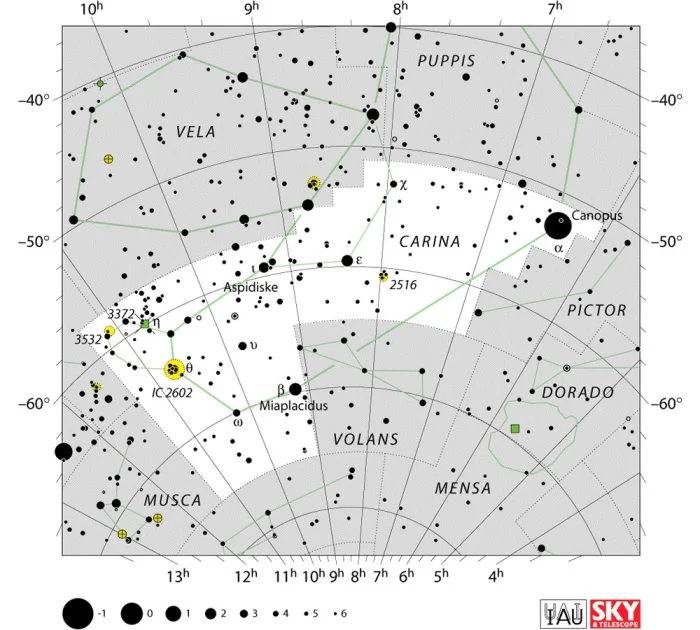
Carina constellation map by IAU and Sky&Telescope magazine
Carina myth
Carina by itself is not associated with any myth in particular, but the larger constellation to which it once belonged – Argo Navis – represented the ship on which Jason and the Argonauts sailed to Colchis (western part of present-day Georgia, on the Black Sea) to get the Golden Fleece.
Argo Navis was one of the 48 constellations known to the Greeks and catalogued by Ptolemy in his Almagest. It occupied a vast area of space between the constellations Canis Major and Crux (the Southern Cross).
The constellation Pyxis (compass), created from stars that used to form the constellation Malus, which represented the ship’s mast in ancient times, was added near the ship later.
Carina represents the main body of Argo Navis and the star Canopus marks the blade on one of the ship’s steering oars.
The ship was named after its creator Argus, who built it under the orders of Athena, using timber from Mount Pelion. Athena fitted the ship with an oak beam from the oracle of Zeus at Dodona, believed to be the oldest Hellenic oracle. The oak beam, as the myth goes, was able to speak because it was part of an oracle.
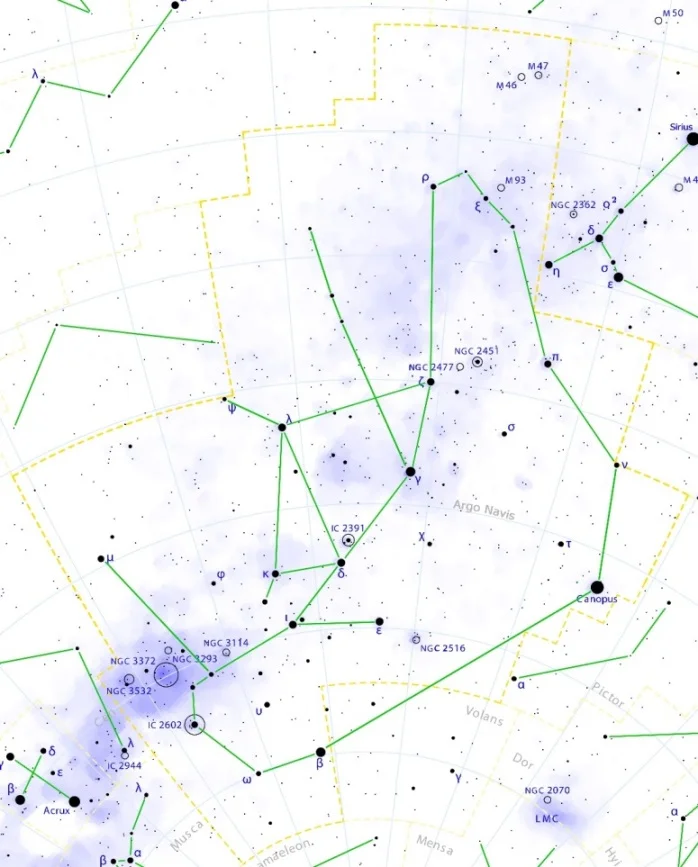
Argo Navis constellation map, image: Torsten Bronger
When the ship was built, Jason and the Argonauts – 50 greatest Greek heroes, among them Heracles, Orpheus and the twins Castor and Polydeuces – set sail to Colchis. On the way, they faced the Clashing Rocks (Symplegades) that guarded the entrance to the Black Sea and crushed all ships that passed between them. Argo Navis was said to be the first ship that passed between them and stayed in one piece. Once in Colchis, Jason and the Argonauts took the Golden Fleece from King Aeëtes and went back to Greece, where Jason beached the ship at Corinth and dedicated it to the sea god Poseidon.
Centuries later, Sir Isaac Newton suggested that the voyage of Argo Navis was commemorated in the sky in the 12 signs of the zodiac, but the connections are not quite obvious.
In another myth, the star Canopus was named after King Menelaus’ helmsman Canopus, who met his end after being bitten by a snake in Egypt when Menelaus’ fleet, driven by a storm, landed there on the way back from Troy. Menelaus buried his helmsman with full honours and the site of Canopus’ grave became a city named after him, located at the mouth of the Nile. (The city is the present-day Abu Qir.)
Carina stars
Canopus – α Carinae (Alpha Carinae)
Canopus is the second brightest star in the night sky, fainter only than Sirius in the constellation Canis Major. When observed from latitudes south of 37°18’, the star never sets below the horizon. At the same time, Canopus never rises north of 37°18’ and it cannot be observed from far-northern latitudes.
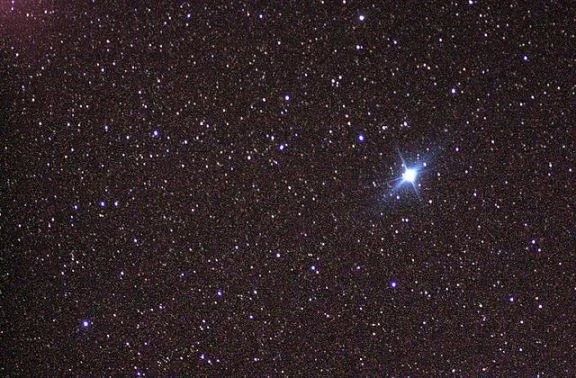
Canopus (Alpha Carinae), image: NASA
Canopus is an F-type bright giant with an apparent magnitude of -0.74 and an absolute magnitude of -5.53. It is 13,600 times brighter than the Sun and the most luminous star within about 700 light years. It is 310 light years distant.
The star’s name is a Latinised version of the Greek name Kanôbos, documented in Ptolemy’s Almagest, presumably referring to the pilot of the ship that took Menelaus to Troy to retrieve Helen. Canopus is known by another name, Suhail (Soheil, Süheyl, Suhel, Suhayl), derived from the Arabic name for several bright stars, including Lambda Velorum (now formally known as Suhail) and Regor in the constellation Vela. The Chinese know Canopus as the Star of the Old Man. The Old Man of the South Pole is the Taoist deification on the star, which is the symbol of longevity and happiness in the Far East.
Canopus belongs to the Scorpius-Centaurus Association, the nearest OB association (a young group of stars that share a common origin and movement, belonging to the spectral classes O and B) to our solar system. Antares and many other bright stars in the constellations Scorpius, Centaurus, Crux and Lupus belong to the association.
η Carinae (Eta Carinae)
Eta Carinae is a star system composed of at least two stars, lying between 7,500 and 8,000 light years from Earth. The combined brightness of the stars amounts to four million times the luminosity of the Sun and the most massive star in the system has more than 100 solar masses. Eta Carinae is sometimes known by its traditional names, Tseen She (“heaven’s altar” in Chinese) and Foramen.
The star belongs to the spectral class WR pe. It is classified as a luminous blue variable (LBV) binary star.
Eta Carinae cannot be observed north of latitude 30°N and it does not fall below the horizon south of latitude 30°S. It was first catalogued as a fourth magnitude star by the English astronomer and physicist Edmond Halley in 1677. By 1730, it brightened significantly and became one of the most prominent stars in Carina. By 1782, it dimmed again. In 1843, it was the second brightest star in the sky (after Sirius), with an apparent magnitude of -0.8 and – it bears repeating – at a distance of roughly 7,500 light years (compared to Sirius at 8.6 light years).
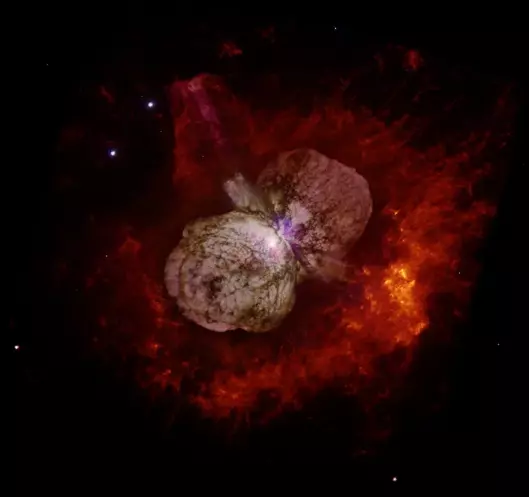
A huge, billowing pair of gas and dust clouds are captured in this stunning NASA Hubble Space Telescope image of the supermassive star Eta Carinae. Eta Carinae was observed by Hubble in September 1995 with the Wide Field and Planetary Camera 2 (WFPC2). Images taken through red and near-ultraviolet filters were subsequently combined to produce the color image shown. A sequence of eight exposures was necessary to cover the object’s huge dynamic range: the outer ejecta blobs are 100,000 times fainter than the brilliant central star. Eta Carinae underwent a giant outburst about 160 years ago, when it became one of the brightest stars in the southern sky. Though the star released as much visible light as a supernova, it survived the outburst. The event produced two lobes and a large, thin equatorial disk, all moving outward at about 1 million kilometers per hour. Image: Nathan Smith (University of California, Berkeley), and NASA
Eta Carinae occasionally undergoes powerful outbursts, which account for the changes in the star’s brightness, but the cause of these outbursts is unknown. The star is also a known X-ray source.
In 1843, a supernova impostor event was observed in the direction of Eta Carinae. There was a giant eruption and, in the next few years, the star emitted almost as much visible light as a supernova would have produced. However, the star survived, even if it has not yet fully recovered from the event.
Eta Carinae is still expected to end its life as a supernova or hypernova in the relatively near future; within the next several million years or so. Since the star’s current age and stage of evolution are uncertain, it is difficult to predict whether this will happen next year or a millennium from now.
Based on the system’s similarity to that of the star that became the supernova SN 2006jc in UGC 4904 in the constellation Lynx, which had a supernova impostor event in 2004, two years prior to going supernova, some believe that we will definitely live to see the end of Eta Carinae. Others, however, believe that the star has not quite reached the critical stage of evolution and that it still has enough material left for nuclear fusion.
Another possible analogue event, the supernova SN 2006gy, occurred in the spiral galaxy NGC 1260 in the constellation Perseus in 2006. The event and the mechanism that caused it are believed to be analogous to the eventual fate of Eta Carinae.
When Eta Carinae goes supernova or hypernova, it is possible that the event might affect Earth, since the star is only 7,500 light years away. While the Earth’s atmosphere will protect the population from the gamma rays and the magnetosphere from some other types of cosmic rays, the upper layers of the atmosphere, the ozone layer, satellites, and spacecraft could be damaged and any astronauts who happen to be in space could be harmed.
Miaplacidus – β Carinae (Beta Carinae)
Miaplacidus is the second brightest star in the constellation and the 29th brightest star in the sky. It has an apparent magnitude of 1.67. The star’s name means “placid waters.” It is derived from the combination of the Arabic word for waters (miyāh) and the Latin word for placid (placidus).
Miaplacidus is an A-type subgiant, approximately 111 light years distant.
The star is part of the south polar asterism, the Diamond Cross, along with Theta, Upsilon and Omega Carinae. The Diamond Cross, named for its perfect diamond shape, is visible south of 20°N latitude.
Miaplacidus is located close to IC 2448, an elliptical planetary nebula in the Carina constellation.
Avior – ε Carinae (Epsilon Carinae)
Epsilon Carinae is the 40th brightest star in the sky. It has an apparent magnitude of 1.86 and is 630 light years distant. It cannot be observed from many locations in the northern hemisphere.
Epsilon Carinae is a double star that consists of a K0 III class orange giant, one approaching the end of its life, and a hot hydrogen-fusing blue dwarf belonging to the spectral class B2 V. The two components regularly eclipse each other, causing variations in luminosity by 0.1 magnitudes.
The name Avior was assigned to the star in the late 1930s. Her Majesty’s Nautical Almanac Office published a navigational almanac for the Royal Air Force, one that included 57 stars that pilots could navigate by. Two stars did not have traditional names, only designations; Epsilon Carinae and Alpha Pavonis. The RAF insisted that all stars have names, so Alpha Pavonis, the brightest star in the constellation Pavo, became Peacock (pavo is the Latin word for peacock), while Epsilon Carinae was named Avior.
Aspidiske – ι Carinae (Iota Carinae)
Iota Carinae is the 68th brightest star in the sky. It is known by the names Aspidiske, Turais and Scutulum, all diminutives of the word “shield,” in Greek, Arabic and Latin respectively.
Iota Carinae belongs to the spectral type A8 Ib. It is a rare white supergiant, one with a luminosity of 4,900 Suns and seven times the mass. The star’s age is estimated to be around 40 million years.
Iota Carinae has an apparent magnitude of 2.21 and is about 690 light years distant. It is best known in southern latitudes for being part of the False Cross asterism, along with Avior, and the stars Delta and Kappa Velorum in the constellation Vela.
The False Cross got its name because it is often mistaken for the Southern Cross, the asterism dominating the constellation Crux.
θ Carinae (Theta Carinae)
Theta Carinae lies on the northeastern end of the Diamond Cross. It is a blue-white main sequence dwarf belonging to the spectral class B0Vp. It has an apparent magnitude of 2.74 and is 439 light years distant.
Theta Carinae is the most prominent star in IC 2602, an open cluster of stars in Carina that is sometimes called the Southern Pleiades because it resembles the famous Pleiades (Seven Sisters) cluster, also known as Messier 45, in the Taurus constellation.
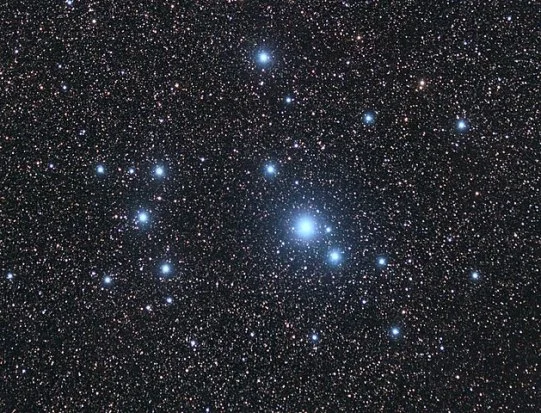
Theta Carinae Cluster – the Southern Pleiades, image: Wikimedia Commons/Tel Lekatsas (CC BY 2.0)
υ Carinae (Upsilon Carinae)
Upsilon Carinae is another double star in the constellation. It consists of a white A-type supergiant and a blue-white B-type giant that are separated by five arc seconds in the sky. The apparent magnitudes of the two stars are 3.01 and 6.26 respectively. The star system is 1,623 light years distant.
ω Carinae (Omega Carinae)
Omega Carinae is a blue-white B-type giant approximately 370 light years distant. It has an apparent magnitude of 3.29. It is one of the stars that form the Diamond Cross.
Other notable stars:
AG Carinae is a luminous blue variable star, one of the brightest stars known in the Milky Way, with an absolute magnitude of -10.3. The star is approximately 6,000 light years distant and its apparent magnitude varies between 5.7 and 9.0. It is surrounded by a large planetary nebula and believed to be undergoing the transitional evolutionary phase between an O-class supergiant and a Wolf-Rayet star.
PP Carinae is a blue-white B-type main sequence dwarf, approximately 497 light years from Earth. It is a shell star, a Gamma Cassiopeiae type variable (fast rotating star with a disc of gas surrounding it at the equator), and has a mean apparent magnitude of 3.30.
V337 Carinae is a K-type bright giant, a variable star with an apparent magnitude varying between 3.36 and 3.44. It is about 740 light years distant.
V357 Carinae is a spectroscopic eclipsing binary star with a mean apparent magnitude of 3.43. It is approximately 419 light years distant. The star is composed of two blue-white B-type subgiants with an orbital period of 6.75 days.
χ Carinae (Chi Carinae) is a blue-white subgiant approximately 387 light years distant. It is a Beta Cephei type variable star (exhibiting variations in brightness due to pulsations on its surface), with its brightness varying by 0.015 magnitudes with a period of 2.42 hours. It has a mean apparent magnitude of 3.46.
I Carinae (HD 84810) is a yellow G-type supergiant approximately 1,510 light years distant. It is classified as a Cepheid variable star and has a mean apparent magnitude of 3.69. Its brightness varies between magnitudes 3.28 and 4.18 with a period of 35.54 days.
V382 Carinae is a yellow G-type hypergiant, 5930.90 light years distant. It is also classified as a Cepheid variable star and its luminosity varies from magnitude 3.84 to 4.02. The star is 747 times the size of the Sun.
V533 Carinae (x Carinae) is a white A-type supergiant, approximately 4,000 light years distant. It is classified as an Alpha Cygni type variable star and has a mean apparent magnitude of 4.59.
Deep sky objects in Carina
Carina Nebula (Eta Carinae Nebula, NGC 3372)
The Eta Carinae Nebula is a large nebula surrounding the massive stars Eta Carinae and HD 93129A, as well as several open star clusters. It is one of the largest diffuse nebulae known, being brighter and four times the size of the Orion Nebula (Messier 42) in Orion constellation. If it is not better known, it is probably because it lies far in the southern hemisphere.
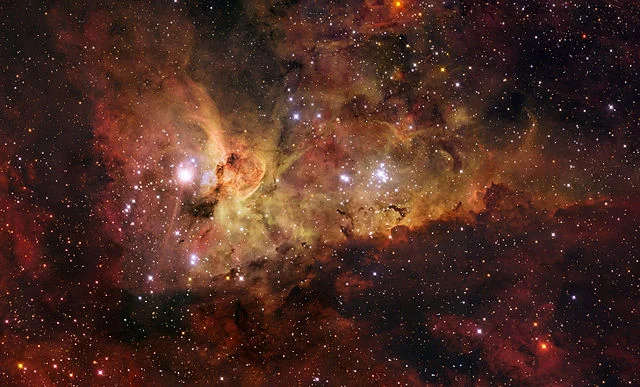
The Carina Nebula is a large bright nebula that surrounds several clusters of stars. It contains two of the most massive and luminous stars in our Milky Way galaxy, Eta Carinae and HD 93129A. Located 7500 light years away, the nebula itself spans some 260 light years across, about 7 times the size of the Orion Nebula, and is shown in all its glory in this mosaic. It is based on images collected with the 1.5-m Danish telescope at ESO’s La Silla Observatory. Being brighter than one million Suns, Eta Carinae (the brightest star in this image) is the most luminous star known in the Galaxy, and has most likely a mass over 100 times that of the Sun. It is the closest example of a luminous blue variable, the last phase in the life of a very massive star before it goes supernova. Eta Carinae is surrounded by an expanding bipolar cloud of dust and gas known as the Homunculus (little man in Latin), which astronomers believe was expelled from the star during a great outburst seen in 1843. Image: ESO/IDA/Danish 1.5 m/R.Gendler, J-E. Ovaldsen, C. Thöne, and C. Feron.
The nebula is between 6,500 and 10,000 light years distant and has an apparent magnitude of 1.0. It contains several O-type stars (hot, bluish, exceptionally luminous stars; the rarest type among the main sequence stars).
It was discovered by the French astronomer Nicolas Louis de Lacaille in 1751-52, who observed it from the Cape of Good Hope.
The Carina Nebula contains two smaller nebulae, the Homunculus Nebula and the Keyhole Nebula.
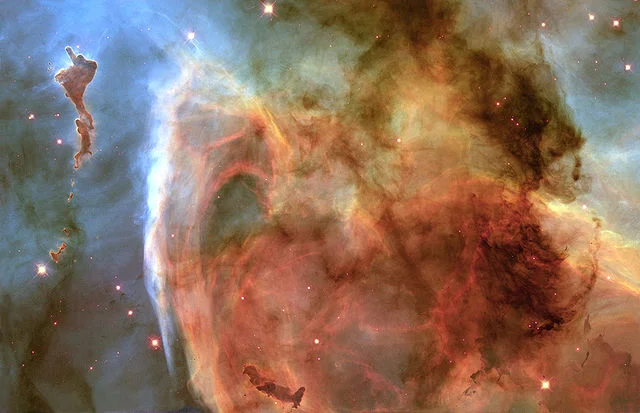
The Keyhole Nebula, image: NASA, The Hubble Heritage Team (AURA, STScI)
The Keyhole Nebula was named by John Herschel in the 19th century. It is a small, dark cloud of dust and cold molecules with bright filaments of fluorescent gas that appears contrasted against the bright nebula in the background. It is about seven light years in diameter.
The Homunculus Nebula is an emission nebula embedded within the Eta Carinae Nebula, immediately surrounding the star Eta Carinae.
Homunculus means “little man” in Latin. The nebula is believed to have formed after an enormous outburst from the star, one that was observed from Earth in 1841, when Eta Carinae became the second brightest star in the night sky.
The near-supernova event resulted in the formation of two polar lobes and a thin equatorial disk, all moving away from the central star at 670 km/s.
The origin of the nebula’s shape has been much theorized about, but there is no conclusive explanation for the peanut shape. Possibly, the central star – or binary star – has the same shape, or the waves sent out by the event in 1841 have created a standing wave at the centre, or there are two small black holes inside the nebula, or there is some other mechanism at play.
Theta Carinae Cluster (Southern Pleiades, IC 2602, Caldwell 102)
The Theta Carinae Cluster, also known as the Southern Pleiades because of its resemblance to the famous cluster in the constellation Taurus, is an open cluster, approximately 479 light years distant, and visible to the unaided eye. It has an apparent magnitude of 1.9. The cluster was discovered by Lacaille in 1751.
The brightest star in the cluster, as the name indicates, is Theta Carinae, a blue-white dwarf. The cluster spans about 50 arc minutes and contains about 60 stars in total, most of them fifth magnitude and fainter.
Wishing Well Cluster (NGC 3532)
NGC 3532 is an open cluster in Carina. Approximately 1,321 light years distant, the cluster is composed of about 150 stars, the brightest of which are seventh magnitude.
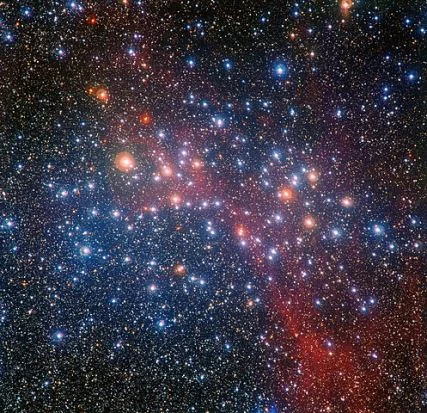
The MPG/ESO 2.2-metre telescope at ESO’s La Silla Observatory in Chile captured this richly colourful view of the bright star cluster NGC 3532. Some of the stars still shine with a hot bluish colour, but many of the more massive ones have become red giants and glow with a rich orange hue. Image: ESO/G. Beccari
It is also known as the Wishing Well Cluster because, in a telescope, its stars appear like silver coins twinkling at the bottom of a wishing well. The cluster lies between the constellation Crux (the Southern Cross) and the False Cross asterism in Carina and Vela.
The Wishing Well Cluster was the first object ever observed by the Hubble Space Telescope in May 1990.
NGC 3603
NGC 3603 is an open cluster approximately 20,000 light years distant. It lies in the Carina spiral arm of the Milky Way Galaxy.
It is a frequent target for astronomers studying star formation because it is a starburst region located relatively nearby and with an apparent magnitude of 9.1 it is relatively bright, too. NGC 3603 was originally catalogued by John Herschel as a nebula in 1847.
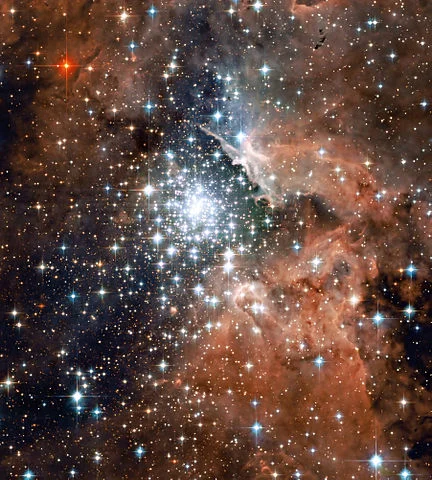
Open star cluster and nebula NGC 3603 by Hubble Space Telescope (ACS). Image: NASA, ESA, and the Hubble Heritage (STScI/AURA)-ESA/Hubble Collaboration
The cluster contains at least three Wolf-Rayet stars (very hot stars with more than 20 solar masses), one of them 200 times more massive than the Sun.
The cluster is surrounded by a H II region, the most massive visible cloud of plasma and gas in the Milky Way. It is also the site of the densest concentration of massive stars known in the galaxy.
The central star, HD 97950, has an apparent magnitude of 9.03. It is in fact a multiple star system, sometimes considered a star cluster in itself, composed of four stars of the type A1-A3 and B, and five other stars.
NGC 2808
NGC 2808 is a globular star cluster with an apparent magnitude of 7.8. It is one of the most massive clusters in the Milky Way Galaxy. The cluster’s age is estimated to be around 12.5 billion years.
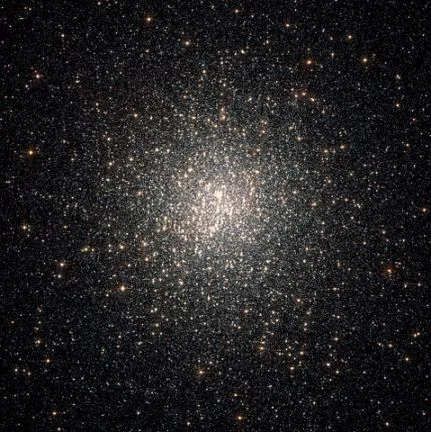
This Hubble Space Telescope (HST) image of a dense swarm of stars shows the central region of the globular cluster NGC 2808 and its three generations of stars. Image: NASA, ESA, A. Sarajedini (University of Florida) and G. Piotto (University of Padua)
NGC 2808 is notable for being composed of three different generations of stars, all formed within 200 million years of the cluster’s formation.
Diamond Cluster (NGC 2516, Caldwell 96, C96)
The Diamond Cluster, named for its stellar clarity, is an open cluster near the constellation Volans. It was discovered by Lacaille in 1751-52. Among its brightest stars are two magnitude five red giants and three binary stars. The cluster can easily be seen without binoculars in good conditions.
NGC 3293
NGC 3293 is an open star cluster in the constellation, discovered by Lacaille in the mid-18th century. The cluster contains over 50 stars spread across an area of 10 arc minutes. The brightest star in the cluster is a magnitude 6.5 red giant.